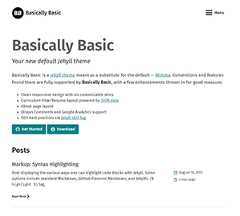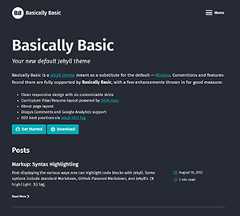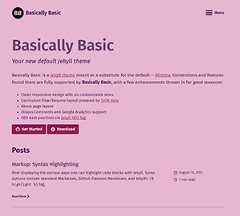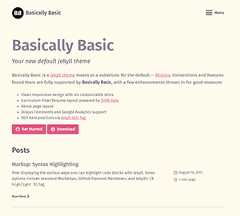- Notifications
You must be signed in to change notification settings - Fork0
Your new Jekyll default theme
License
SSoder/jekyll-theme-basically-basic
Folders and files
| Name | Name | Last commit message | Last commit date | |
|---|---|---|---|---|
Repository files navigation
Basically Basic is aJekyll theme meant asa substitute for the defaultMinima, with afew enhancements thrown in for good measure:
- Clean responsive design withsix customizable skins
- Curriculum Vitæ/Resume layout powered byJSON data
- About page layout
- Site-wide search provided byAlgolia orLunr.
- Disqus Comments and Google Analytics support
- SEO best practices viaJekyll SEO Tag
- Installation
- Upgrading
- Structure
- Configuration
- Layouts
- Images
- Customization
- Development
- Contributing
- Credits
- License
If you're running Jekyll v3.5+ and self-hosting you can quickly install thetheme as a Ruby gem. If you're hosting with GitHub Pages you can install as aremote theme or directly copy all of the theme files (seestructurebelow) into your project.
Add this line to your Jekyll site's
Gemfile:gem"jekyll-theme-basically-basic"
Add this line to your Jekyll site's
_config.ymlfile:theme:jekyll-theme-basically-basic
Then runBundler to install the theme gem and dependencies:
bundle install
GitHub Pages has addedfull supportfor any GitHub-hosted theme.
Replace
gem "jekyll"with:gem"github-pages",group::jekyll_plugins
Run
bundle updateand verify that all gems install properly.Add
remote_theme: "mmistakes/jekyll-theme-basically-basic"to your_config.ymlfile. Remove any othertheme:orremote_theme:entries.
Note: Your Jekyll site should be viewable immediately athttp://USERNAME.github.io. If it's not, you can force a rebuild byCustomizing Your Site (see below for more details).
If you're hosting several Jekyll based sites under the same GitHub username youwill have to use Project Pages instead of User Pages. Essentially you rename therepo to something other thanUSERNAME.github.io and create agh-pagesbranch off ofmaster. For more details on how to set things up checkGitHub's documentation.
If you forked or downloaded thejekyll-theme-basically-basic repo you cansafely remove the following files and folders:
.editorconfig.gitattributes.github.scss-lint.ymlCHANGELOG.mdjekyll-theme-basically-basic.gemspecLICENSE.mdRakefileREADME.mdscreenshot.png/docs/example
If you're using the Ruby Gem or remote theme versions of Basically Basic,upgrading is fairly painless.
To check which version you are currently using, view the source of your builtsite and you should something similar to:
<!-- Basically Basic Jekyll Theme 1.2.0 Copyright 2017-2018 Michael Rose - mademistakes.com | @mmistakes Free for personal and commercial use under the MIT license https://github.com/mmistakes/jekyll-basically-theme/blob/master/LICENSE.md-->At the top of every.html file,/assets/css/main.css, and/assets/js/main.js.
Simply runbundle update if you're using Bundler (have aGemfile) orgem update jekyll-theme-basically-basic if you're not.
When hosting with GitHub Pages you'll need to push up a commit to force arebuild with the latesttheme release.
An empty commit will get the job done too if you don't have anything to push atthe moment:
git commit --allow-empty -m "Force rebuild of site"If you want to get the most out of the Jekyll + GitHub Pages workflow, thenyou'll need to utilize Git. To pull down theme updates you must first ensurethere's an upstream remote. If you forked the theme's repo then you're likelygood to go.
To double check, rungit remote -v and verify that you can fetch fromorigin https://github.com/mmistakes/jekyll-theme-basically-basic.git.
To add it you can do the following:
git remote add upstream https://github.com/mmistakes/jekyll-theme-basically-basic.gitNow you can pull any commits made to theme'smaster branch with:
git pull upstream masterDepending on the amount of customizations you've made after forking, there'slikely to be merge conflicts. Work through any conflicting files Git flags,staging the changes you wish to keep, and then commit them.
Another way of dealing with updates isdownloading the theme--- replacing your layouts, includes, and assets with the newer ones manually.To be sure that you don't miss any changes it's probably a good idea to reviewthe theme'scommit historyto see what's changed since.
Here's a quick checklist of the important folders/files you'll want to bemindful of:
| Name | |
|---|---|
_layouts | Replace all. Apply edits if you customized any layouts. |
_includes | Replace all. Apply edits if you customized any includes. |
assets | Replace all. Apply edits if you customized stylesheets or scripts. |
_sass | Replace all. Apply edits if you customized Sass partials. |
_data/theme.yml | Safe to keep. Verify that there were no major structural changes or additions. |
_config.yml | Safe to keep. Verify that there were no major structural changes or additions. |
Note: If you're not seeing the latest version, be sure to flush browser andCDN caches. Depending on your hosting environment older versions of/assets/css/main.css,/assets/js/main.js, or*.html may be cached.
Layouts, includes, Sass partials, and data files are all placed in their defaultlocations. Stylesheets and scripts inassets, and a few development relatedfiles in the project's root directory.
Please note: If you installed Basically Basic via the Ruby Gem method, themefiles found in/_layouts,/_includes,/_sass, and/assets will bemissing. This is normal as they are bundled with thejekyll-theme-basically-basic gem.
jekyll-theme-basically-basic├── _data # data files| └── theme.yml # theme settings and custom text├── _includes # theme includes and SVG icons├── _layouts # theme layouts (see below for details)├── _sass # Sass partials├── assets| ├── javascripts| | └── main.js| └── stylesheets| └── main.scss├── _config.yml # sample configuration└── index.md # sample home page (all posts/not paginated)After creating aGemfile and installing the theme you'll need to add and editthe following files:
Note: Consult thepagination documentation below forinstructions on how to enable it for the home page.
Using thejekyll new command will get you up and running the quickest.
Edit_config.yml and create_data/theme.yml as instructed above and you'regood to go.
Configuration of site-wide elements (lang,title,description,logo,author, etc.) happens in your project's_config.yml. See theexample configuration in this repo for additionalreference.
| Description | |
|---|---|
lang | Used to indicate the language of text (e.g., en-US, en-GB, fr) |
title | Your site's title (e.g., Dungan's Awesome Site) |
description | Short site description (e.g., A blog about grasshopper mash) |
url | The full URL to your site (e.g.,https://groverloaf.org) |
author | Global author information (see below) |
logo | Path to a site-wide logo ~100x100px (e.g., /assets/your-company-logo.png) |
twitter_username | Site-wide Twitter username, used as a link in sidebar |
github_username | Site-wide GitHub username, used as a link in sidebar |
For more configuration options be sure to consult the documentation for:jekyll-seo-tag,jekyll-feed,jekyll-paginate, andjekyll-sitemap.
This theme comes in six different skins (color variations). To change skins addone of the following to your/_data/theme.yml file:
skin: default | skin: night | skin: plum |
|---|---|---|
 |  |  |
skin: sea | skin: soft | skin: steel |
|---|---|---|
 |  |  |
This theme allows you to easily useGoogle Fontsthroughout the theme. Simply add the following to your/_data/theme.yml, replacing the fontname andweightsaccordingly.
google_fonts: -name:"Fira Sans"weights:"400,400i,600,600i" -name:"Fira Sans Condensed"
To change text found throughout the theme add the following to your/_data/theme.yml file and customize as necessary.
t:skip_links:"Skip links"skip_primary_nav:"Skip to primary navigation"skip_content:"Skip to content"skip_footer:"Skip to footer"menu:"Menu"home:"Home"newer:"Newer"older:"Older"email:"Email"subscribe:"Subscribe"read_more:"Read More"posts:"Posts"page:"Page"of:"of"min_read:"min read"present:"Present"
By default all internal pages with atitle will be added to the "off-canvas"menu. For more granular control and sorting of these menu links:
Create a custom list to override the default setting by adding a
navigation_pagesarray to your/_data/theme.ymlfile.Add raw page paths in the order you'd like:
navigation_pages: -about.md -cv.md
Each menu link's title and URL will be populated based on theirtitle andpermalink respectively.
Break up the main listing of posts into smaller lists and display them overmultiple pages byenabling pagination.
Include the
jekyll-paginateplugin in yourGemfile.group:jekyll_pluginsdogem"jekyll-paginate"end
Add
jekyll-paginatetogemsarray in your_config.ymlfile and thefollowing pagination settings:paginate:5# amount of posts to show per pagepaginate_path:/page:num/
Create
index.html(or renameindex.md) in the root of your project andadd the following front matter:layout:homepaginate:true
To enable site-wide search addsearch: true to your_config.yml.
The default search usesLunr to build a search index of all your documents. This method is 100% compatible with sites hosted on GitHub Pages.
Note: Only the first 50 words of a post or page's body content is added to the Lunr search index. Settingsearch_full_content totrue in your_config.yml will override this and could impact page load performance.
For faster and more relevant search (see demo):
Add the
jekyll-algoliagem to yourGemfile, in the:jekyll_pluginssection.group:jekyll_pluginsdogem"jekyll-feed"gem"jekyll-seo-tag"gem"jekyll-sitemap"gem"jekyll-paginate"gem"jekyll-algolia"end
Once this is done, download all dependencies by running
bundle install.Switch search providers from
lunrtoalgoliain your_config.ymlfile:search_provider:algolia
Add the following Algolia credentials to your
_config.ymlfile.If you don't have an Algolia account, you can open a freeCommunity plan. Once signed in, you can grab your credentials fromyour dashboard.algolia:application_id:# YOUR_APPLICATION_IDindex_name:# YOUR_INDEX_NAMEsearch_only_api_key:# YOUR_SEARCH_ONLY_API_KEYpowered_by:# true (default), false
Once your credentials are setup, you can run the indexing with the following command:
ALGOLIA_API_KEY=your_admin_api_key bundle exec jekyll algoliaFor Windows users you will have to use
setto assigned theALGOLIA_API_KEYenvironment variable.set ALGOLIA_API_KEY=your_admin_api_keybundle exec jekyll algoliaNote that
ALGOLIA_API_KEYshould be set to your admin API key.
To use the Algolia search with GitHub Pages hosted sites followthis deployment guide. Or this guide fordeploying on Netlify.
Note: The Jekyll Algolia plugin can be configured in several ways. Be sure to check outtheir full documentation on how to exclude files and other valuable settings.
Author information is used as meta data for post "by lines" and propagates thecreator field of Twitter summary cards with the following front matter in_config.yml:
author:name:John Doetwitter:johndoetwitterpicture:/assets/images/johndoe.png
Site-wide author information can be overridden in a document's front matter inthe same way:
author:name:Jane Doetwitter:janedoetwitterpicture:/assets/images/janedoe.png
Or by specifying a corresponding key in the document's front matter, thatexists insite.data.authors. E.g., you have the following in the document'sfront matter:
author:megaman
And you have the following in_data/authors.yml:
megaman:name:Mega Mantwitter:megamantwitterpicture:/assets/images/megaman.pngdrlight:name:Dr. Lighttwitter:drlighttwitterpicture:/assets/images/drlight.png
Currentlyauthor.picture is only used inlayout: about. Recommended size is300 x 300 pixels.
To enable reading time counts addread_time: true to a post or page's YAMLFront Matter.
Optionally, if you have aDisqus account, you can show acomments section below each post.
To enable Disqus comments, add yourDisqus shortname to your project's_config.yml file:
disqus:shortname:my_disqus_shortname
Comments are enabled by default and will only appear in production when builtwith the followingenvironment value:JEKYLL_ENV=production
If you don't want to display comments for a particular post you can disablethem by addingcomments: false to that post's front matter.
To enable Google Analytics, add yourtracking IDto_config.yml like so:
google_analytics:UA-NNNNNNNN-N
Similar to comments, the Google Analytics tracking script will only appear inproduction when using the following environment value:JEKYLL_ENV=production.
This theme provides the following layouts, which you can use by setting thelayoutFront Matter on each page,like so:
---layout:name---
This layout handles all of the basic page scaffolding placing the page contentbetween the masthead and footer elements. All other layouts inherit this oneand provide additional styling and features inside of the{{ content }} block.
This layout accommodates the following front matter:
# optional alternate title to replace page.title at the top of the pagealt_title:"Basically Basic"# optional sub-title below the page titlesub_title:"The name says it all"# optional intro text below titles, Markdown allowedintroduction:| Basically Basic is a Jekyll theme meant to be a substitute for the default --- [Minima](https://github.com/jekyll/minima). Conventions and features found in Minima are fully supported by **Basically Basic**.# optional call to action linksactions: -label:"Learn More"icon:github# references name of svg icon, see full list belowurl:"http://url-goes-here.com" -label:"Download"icon:download# references name of svg icon, see full list belowurl:"http://url-goes-here.com"image:# URL to a hero image associated with the post (e.g., /assets/page-pic.jpg)# post specific author data if different from what is set in _config.ymlauthor:name:John Doetwitter:johndoetwittercomments:false# disable comments on this post
Note: Hero images can be overlaid with a transparent "accent" color to unify them with the theme's palette. To enable,customize the CSS with the following Sass variable override:
$intro-image-color-overlay: true;Visually this layout looks and acts the same aslayout: post, with two minordifferences.
- Author "by line" and publish date are omitted.
- Disqus comments are omitted.
This layout accommodates the same front matter aslayout: page, with theaddition of the following:
paginate:true# enables pagination loop, see section above for additional setupentries_layout:# list (default), grid
By default, posts are shown in a list view. To change to a grid view addentries_layout: grid to the page's front matter.
This layout displays all posts grouped by the year they were published. It accommodates the same front matter aslayout: page.
By default, posts are shown in a list view. To change to a grid view addentries_layout: grid to the page's front matter.
This layout displays all posts grouped category. It accommodates the same front matter aslayout: page.
By default, posts are shown in a list view. To change to a grid view addentries_layout: grid to the page's front matter.
This layout displays all posts grouped by tag. It accommodates the same front matter aslayout: page.
By default, posts are shown in a list view. To change to a grid view addentries_layout: grid to the page's front matter.
This layout displays all documents grouped by a specific collection. It accommodates the same front matter aslayout: page with the addition of the following:
collection:# collection nameentries_layout:# list (default), gridshow_excerpts:# true (default), falsesort_by:# date (default) titlesort_order:# forward (default), reverse
To create a page showing all documents in therecipes collection you'd createrecipes.md in the root of your project and add this front matter:
title:Recipeslayout:collectionpermalink:/recipes/collection:recipes
By default, documents are shown in a list view. To change to a grid view addentries_layout: grid to the page's front matter. If you want to sort the collection by title addsort_by: title. If you want reverse sorting, addsort_order: reverse.
This layout displays all posts grouped by a specific category. It accommodates the same front matter aslayout: page with the addition of the following:
taxonomy:# category nameentries_layout:# list (default), grid
By default, posts are shown in a list view. To change to a grid view addentries_layout: grid to the page's front matter.
To create a page showing all posts assigned to the categoryfoo you'd createfoo.md in the root of your project and add this front matter:
title:Foolayout:categorypermalink:/categories/foo/taxonomy:foo
This layout displays all posts grouped by a specific tag. It accommodates the same front matter aslayout: page with the addition of the following:
taxonomy:# tag nameentries_layout:# list (default), grid
By default, posts are shown in a list view. To change to a grid view addentries_layout: grid to the page's front matter.
To create a page showing all posts assigned to the tagfoo bar you'd createfoo-bar.md in the root of your project and add this front matter:
title:Foo Barlayout:tagpermalink:/tags/foo-bar/taxonomy:foo bar
This layout accommodates the same front matter aslayout: page, with theaddition of the following to display an author picture:
author:name:John Doepicture:/assets/images/johndoe.png
Recommendedpicture size is approximately300 x 300 pixels. Ifauthorobject is not explicitly set in the about page's front matter the themewill default to the value set in_config.yml.
If blank there no image will appear.
This layout accommodates the same front matter aslayout: page. Itleverages aJSON-based file standard forresume data to conveniently render a curriculum vitæ or resume painlessly.
Simply use JSON Resume'sin-browser resume builderto export a JSON file and save to your project as_data/cv.json.
Suggested image sizes in pixels are as follows:
| Image | Description | Size |
|---|---|---|
page.image.path | Large full-width document image. | Tall images will push content down the page.1600 x 600 is a good middle-ground size to aim for. |
page.image | Short-hand forpage.image.path when used alone (withoutthumbnail,caption, or other variables). | Same aspage.image.path |
page.image.thumbnail | Small document image used in grid view. | 400 x 200 |
author.picture | Author page image. | 300 x 300 |
The default structure, style, and scripts of this theme can be overridden andcustomized in the following two ways.
Theme defaults can beoverriddenby placing a file with the same name into your project's_includes or_layouts directory. For instance:
- To specify a custom style path or meta data to the
_includes/head.htmlfile, create an_includesdirectory in your project, copy_includes/head.htmlfrom Basically Basic's gem folder to<your_project>/_includesand start editing that file.
ProTip: to locate the theme's files on your computer runbundle show jekyll-theme-basically-basic. This returns the location of thegem-based theme files.
To override the defaultSass (located in theme's_sass directory), do one of the following:
Copy directly from the Basically Basic gem
- Go to your local Basically Basic gem installation directory (run
bundle show jekyll-theme-basically-basicto get the path to it). - Copy the contents of
/assets/stylesheets/main.scssfrom there to<your_project>. - Customize what you want inside
<your_project>/assets/stylesheets/main.scss.
- Go to your local Basically Basic gem installation directory (run
Copy from this repo.
- Copy the contents ofassets/stylesheets/main.scssto
<your_project>. - Customize what you want inside
<your_project/assets/stylesheets/main.scss.
- Copy the contents ofassets/stylesheets/main.scssto
Note: To make more extensive changes and customize the Sass partials bundledin the gem. You will need to copy the complete contents of the_sass directoryto<your_project> due to the way Jekyll currently reads those files.
To make basic tweaks to theme's style Sass variables can be overridden by addingto<your_project>/assets/stylesheets/main.scss. For instance, to change theaccent color used throughout the theme add the following:
$accent-color:red;
To override the default JavaScript bundled in the theme, do one of the following:
Copy directly from the Basically Basic gem
- Go to your local Basically Basic gem installation directory (run
bundle show jekyll-theme-basically-basicto get the path to it). - Copy the contents of
/assets/javascripts/main.jsfrom there to<your_project>. - Customize what you want inside
<your_project>/assets/javascripts/main.js.
- Go to your local Basically Basic gem installation directory (run
Copy from this repo.
- Copy the contents ofassets/javascripts/main.jsto
<your_project>. - Customize what you want inside
<your_project>/assets/javascripts/main.js.
- Copy the contents ofassets/javascripts/main.jsto
The theme uses social network logos and other iconography saved as SVGs forperformance and flexibility. Said SVGs are located in the_includes directoryand prefixed withicon-. Each icon has been sized and designed to fit a16 x 16 viewbox and optimized withSVGO.
Fill colors are defined in the_sass/basically-basic/_icons.scss partial andset with.icon-name where class name matches the corresponding icon.
For example the Twitter icon is given a fill color of#1da1f2 like so:
<spanclass="icon icon--twitter">{% include icon-twitter.svg %}</span>
Alongside the SVG assets, there are icon helper includes to aid in generatingsocial network links.
| Include Parameter | Description | Required |
|---|---|---|
username | Username on given social network | Required |
label | Text used for hyperlink | Optional, defaults tousername |
For example, the followingicon-github.html include:
{%includeicon-github.htmlusername=jekylllabel='GitHub' %}Will output the following HTML:
<ahref="https://github.com/jekyll"><spanclass="icon icon--github"><svgviewBox="0 0 16 16"xmlns="http://www.w3.org/2000/svg"fill-rule="evenodd"clip-rule="evenodd"stroke-linejoin="round"stroke-miterlimit="1.414"><pathd="M8 0C3.58 0 0 3.582 0 8c0 3.535 2.292 6.533 5.47 7.59.4.075.547-.172.547-.385 0-.19-.007-.693-.01-1.36-2.226.483-2.695-1.073-2.695-1.073-.364-.924-.89-1.17-.89-1.17-.725-.496.056-.486.056-.486.803.056 1.225.824 1.225.824.714 1.223 1.873.87 2.33.665.072-.517.278-.87.507-1.07-1.777-.2-3.644-.888-3.644-3.953 0-.873.31-1.587.823-2.147-.09-.202-.36-1.015.07-2.117 0 0 .67-.215 2.2.82.64-.178 1.32-.266 2-.27.68.004 1.36.092 2 .27 1.52-1.035 2.19-.82 2.19-.82.43 1.102.16 1.915.08 2.117.51.56.82 1.274.82 2.147 0 3.073-1.87 3.75-3.65 3.947.28.24.54.73.54 1.48 0 1.07-.01 1.93-.01 2.19 0 .21.14.46.55.38C13.71 14.53 16 11.53 16 8c0-4.418-3.582-8-8-8"></path></svg></span><spanclass="label">GitHub</span></a>
To set up your environment to develop this theme:
- Clone this repo
cdinto/exampleand runbundle install.
To test the theme the locally as you make changes to it:
cdinto the root folder of the repo (e.g.jekyll-theme-basically-basic).- Run
bundle exec rake previewand open your browser tohttp://localhost:4000/example/.
This starts a Jekyll server using the theme's files and contents of theexample/ directory. As modifications are made, refresh your browser to seeany changes.
Found a typo in the documentation? Interested in adding a feature orfixing a bug? Then by all meanssubmit an issue or take astab at submitting apull request. If this is your firstpull request, it may be helpful to read up on theGitHub Flow.
When submitting a pull request:
- Clone the repo.
- Create a branch off of
masterand give it a meaningful name (e.g.my-awesome-new-feature) and describe the feature or fix. - Open a pull request on GitHub.
Sample pages can be found in the/docs and/examplefolders if you'd like to tackle any "low-hanging fruit" like fixing typos, badgrammar, etc.
Michael Rose
The MIT License (MIT)
Copyright (c) 2017-2018 Michael Rose and contributors
Permission is hereby granted, free of charge, to any person obtaining a copyof this software and associated documentation files (the "Software"), to dealin the Software without restriction, including without limitation the rightsto use, copy, modify, merge, publish, distribute, sublicense, and/or sellcopies of the Software, and to permit persons to whom the Software isfurnished to do so, subject to the following conditions:
The above copyright notice and this permission notice shall be included in allcopies or substantial portions of the Software.
THE SOFTWARE IS PROVIDED "AS IS", WITHOUT WARRANTY OF ANY KIND, EXPRESS ORIMPLIED, INCLUDING BUT NOT LIMITED TO THE WARRANTIES OF MERCHANTABILITY,FITNESS FOR A PARTICULAR PURPOSE AND NONINFRINGEMENT. IN NO EVENT SHALL THEAUTHORS OR COPYRIGHT HOLDERS BE LIABLE FOR ANY CLAIM, DAMAGES OR OTHERLIABILITY, WHETHER IN AN ACTION OF CONTRACT, TORT OR OTHERWISE, ARISING FROM,OUT OF OR IN CONNECTION WITH THE SOFTWARE OR THE USE OR OTHER DEALINGS IN THESOFTWARE.
Basically Basic incorporates icons fromThe Noun Project.Icons are distributed under Creative Commons Attribution 3.0 United States (CC BY 3.0 US).
Basically Basic incorporates photographs fromUnsplash.
Basically Basic incorporatesSusy,Copyright (c) 2017, Miriam Eric Suzanne.Susy is distributed under the terms of theBSD 3-clause "New" or "Revised" License.
Basically Basic incorporatesBreakpoint.Breakpoint is distributed under the terms of theMIT/GPL Licenses.
About
Your new Jekyll default theme
Resources
License
Uh oh!
There was an error while loading.Please reload this page.
Stars
Watchers
Forks
Packages0
Languages
- CSS55.0%
- HTML39.7%
- Ruby2.9%
- JavaScript2.4%
